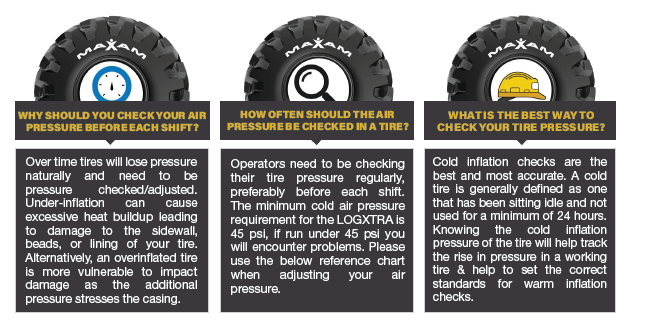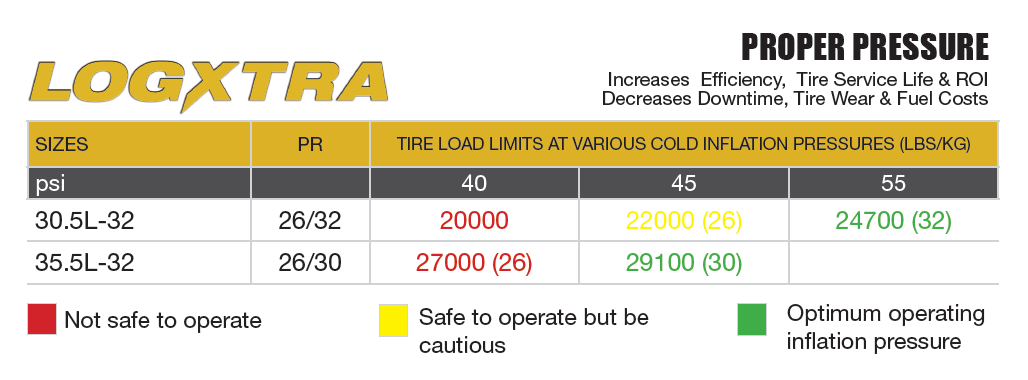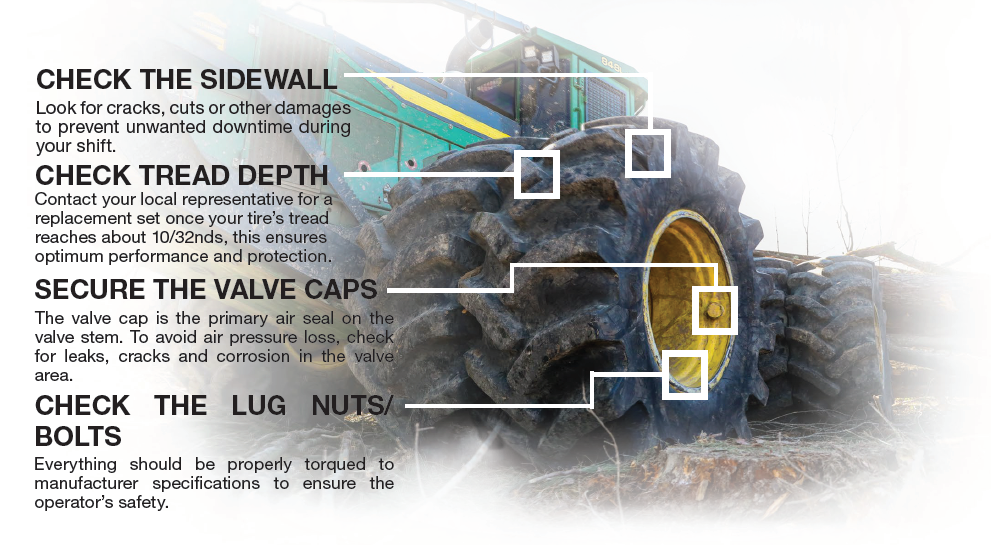MAXAM LOGXTRA Fleet Maintenance Guide
Forestry Technical Bulletin – MAXAM discusses three simple precautions that can help protect your investment, increase site safety, and service life
Forestry tires are a big investment for logging operators and in a business where small increases in efficiency can add up to the difference between profit and loss, it is important to take care of your tires.
Skidders, forwarders, and drive-to-tree feller bunchers all operate in the most extreme off-the-road conditions. Therefore, forestry tires experience drastic changes; from hot to cold temperatures, mud to rocks, and abrasive soil, causing them to wear prematurely or fail if not properly maintained. Some key signs that indicate opportunities for improvement are:
- Lack of traction
- Rapid tread wear
- Excessive punctures or cuts
- Tire separation
- Tire-rim slip
Fortunately, by following these three simple precautions MAXAM recommends, operators can increase their site’s investment return, efficiency, and site safety along with decreasing downtime, tire wear, and fuel costs.
#1 Check your Air Pressure
Tire pressure is the most important factor in tire maintenance. Over time tires will lose pressure naturally and need to be pressure checked/adjusted daily. Running machinery on tires that are not inflated to the manufacturer’s recommended levels of air pressure causes excessive wear, tire separation, and tire-rim slip. The result is reduced tire life, loss of productivity, and increased operating costs.
Keep in mind that underinflation can cause excessive heat buildup leading to damage of the sidewall, beads, or lining of your tire. A drop of 5 psi can lower your load carrying capacity by 10% and a drop of 10% will shorten your tire life by no less than 10%. Alternatively, an overinflated tire is more vulnerable to impact damage as the additional pressure stresses the casing.

How often should the air pressure be checked in a tire? Operators need to be checking their tire pressure regularly, preferably before each shift. Many operators do a walk around, kick the tires, check the fluids, and go to work but not stopping to check your air pressure can cost you valuable tire life. Please note, the minimum cold air pressure requirement for the LOGXTRA is 45psi, if run under 45psi you will encounter problems. Many companies like MAXAM will void workmanship and materials warranties if run under the recommended air pressure, so to protect your investment required minimum pressures must be strictly enforced.
What is the best way to check your tire pressure? Cold inflation checks are the best and most accurate. A cold tire is generally defined as one that has been sitting idle and not used for a minimum of 24 hours. From this point, the pressure can be monitored more accurately. Hot inflation checks, in most cases, are the norm. Therefore, knowing the cold inflation pressure of the tire will help track the rise in pressure in a working tire. This will then help to set the correct standards for warm inflation checks.
As a tire works, its internal temperature will increase, as will its air pressure. A hot tire must never be deflated. If the air pressure increases by 20% or more from the cold inflation reading, it is a signal that the tire is overheating and should be stopped. The tire, then, should cool down or be moved to an operation that is less demanding. If there is any question regarding the continued operation of the tire, consult with a tire manufacturer representative.
A tire operating at the incorrect air pressure, either under or over-inflated, might not show any immediate issues but may fail later, even after its air pressure was corrected. Operating a tire with insufficient air pressure causes the tire’s operating temperature to rise. This can lead to irreversible damage to the tire’s internal components and will shorten its life expectancy. Overinflation, on the other hand, is not good either. It can cause rapid and irregular tire wear. In addition, the tire will be subjected to a greater chance of sustaining cuts in the tread and sidewall due to improper flexing of the tire.

What to do in excess load situations? Due to the specialized nature of forestry usage, actual loads more than those stated in the appropriate load tables listed by the tire manufacturer are often encountered. Excess loads can be a result of the actual vehicle weight exceeding the design weight. This can be due to different attachments being added, varying density of the materials being moved, load transfer, and other factors. Under these conditions, the actual tire load may exceed the load rating noted in the manufacturer’s load table. An example of excess load situations would be transporting the loader from one deck to the other.
If excess loads are encountered, the cold inflation must be increased to compensate for the higher loads. As noted in the manufacturer’s data books, the excess load allowed is 15% with a maximum psi increase of 30%. The customer must be advised that if they are running continually with excess loads, the tires will not perform as well. Questions on proper tire inflation should be discussed with both the tire and rim manufacturer to obtain their approval.
#2 Visual Inspections
Tires should be visually inspected before every shift for cuts and impacts that could lead to tire failure. Routine maintenance inspections can lead to discovering deeper cuts that have exposed plies. In these cases, removing the tire and repairing it immediately can extend the life of the tire, increasing the site’s profitability.
During these routine checks, it is important to look at both the valve caps and the lug nuts/bolts. Securing your valve caps will avoid air pressure loss, cracks, and corrosion in the valve area. All lug nuts/bolts should also be torqued to the manufacturer’s specifications to avoid downtime.

#3 Operator Training
Operator training and behavior are both critical to extending tire life. The operator who avoids unnecessary backing up, spinning of tires, and erratic movements will extend tire life on the site and increase production.
Operators should also select the best driving path whenever possible. Operators need to be aware of the layout in the working area and carefully plan their routes. How steep are the slopes? Are there areas of deep mud or hard-to-spot hollows? Going around an obstacle or mound or steep incline may take longer, but the savings in fuel and tire damage may well make it worthwhile.
If you have any questions on this article or on proper air pressure for the MAXAM LOGXTRA series, please contact our team today at maxamtire.com.



